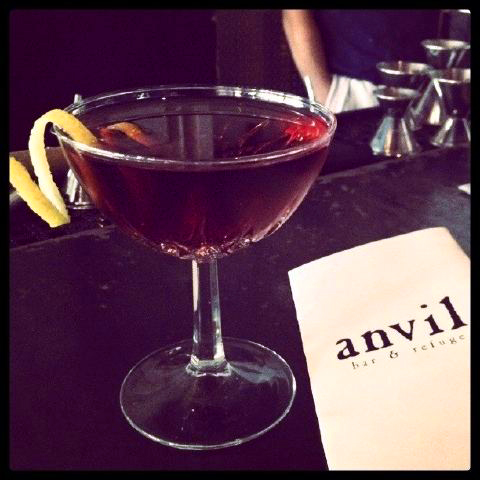Cocktail of the Day: Dubonnet Royal
I have to wonder if Dubonnet Rouge is the red-headed stepchild of aromatized wines these days. It just doesn’t seem to get the attention it once did, and that it deserves now.
I love redheads, by the way.
Dubonnet, if you’re not familiar, is a fortified apéritif wine along similar lines as vermouth, and comes in white and red expressions (rouge and blanc, but not a “dry” version as with vermouth). The vast majority of the time when someone refers to Dubonnet they are referring to Dubonnet Rouge. It’s similar to sweet vermouth, although a fair bit sweeter, with fruitier notes, and it’s very slightly more bitter. Dubonnet Rouge does contain quinine, although I don’t detect a whole lot of it on my palate. The sweetness tends toward a ruby port, although not as richly flavored, and one article compared it to sangria, “with a heavier mouthfeel and a spicier aroma.”
Dubonnet was created in 1846 by a Parisian wine merchant and chemist named Joseph Dubonnet, “as a means to make quinine more palatable for the soldiers battling malaria in North Africa.” Still made in France, but for the American market it’s made in Kentucky by the Heaven Hill distillery. There are those who say the American-made product is inferior to the European one. I’ve never tried it in Europe myself, but my pal Martin Doudoroff (who has an excellent site called Vermouth 101 all about vermouth, quinquinas, americanos and other fortified wines) remarked that “[t]he flavor profile is basically the same as the Kentucky edition and it isn’t dramatically more bitter (maybe a touch—it’s still pretty mild stuff in comparison to, say, Bonal) but it’s also clearly a more carefully wrought product. I guess I’d describe the European product as a little move vital and alive.”
I’m quite fond of Dubonnet Rouge myself, and with the proper adjustments I enjoy swapping it in for sweet vermouth for a nice change of pace. It’s lovely in a Dubonnet Cocktail, half and half with gin (one of the preferred tipples of the late Queen Mother, who in her later eyars was probably tipsy all day long, bless her). We also stumbled across this one in the long out-of-print Café Royal Cocktail Book; it’s also up on CocktailDB.
The original recipe called for orange Curaçao, but given the sweetness of the Dubonnet Wesly decided to go for a slightly drier orange liqueur, the excellent triple sec Combier. Cointreau would also work well.
The original recipe, as with so many recipes of its era, also called for precise proportions yet were vague on exact amounts. It read “2/3 Dubonnet, 1/3 gin, 2 dashes each orange Curaçao and Angostura bitters, dash of absinthe on top.” Given some other instructions gleaned from the preface as well as the typical cocktail size of the time, I’m guessing that he was making 2 to 2-1/2 ounce cocktails. I’ve tried to adjust this slightly for the slightly larger cocktails we tend to drink these days, but by all means make the nice little two-ouncers, especially if you have great little tiny vintage cocktail glasses in your collection. Make those proportions 1 to 1/2, otherwise …
I tweeted this recipe after Wesly made this for us one night, and my friend Maitri, who was at the bar at the wonderful Anvil Bar & Refuge in Houston drinking at the time, read it to our pal Chris Frankel, who was behind the stick that night. Chris thought it sounded good and made one for Maitri on the spot. Good gods, I love the Internets.

Photo by Maitri Erwin, used with her kind permission. Drink made by Chris Frankel at Anvil Bar & Refuge, Houston
DUBONNET ROYAL
(collected by W. J. Tarling, American Bar, Café Royal, London, 1937)1-1/2 ounces Dubonnet Rouge
3/4 ounce London dry gin
1 barspoon Combier Liqueur d’Orange
3 dashes Angostura bitters
1 dash absinthe
1 Luxardo cherryCombine the first four ingredients with ice in a mixing glass and stir for 20-30 seconds. Strain into a chilled cocktail coupe. Top with the dash of absinthe and garnish with the cherry.
Wililam J. Tarling was the head bartender of London’s sadly long-lost Café Royal as well as president of the United Kingdom Bartenders’ Guild, and in 1937 compiled a wonderful book of recipes invented by himself, his fellow Café Royal bartenders as well as other members of the UKBG. He was also a good, charitable fellow, as evidenced by this preface to the edition:
ALL Royalties derived by W. J. Tarling from this book are to be equally divided between the United Kingdom Bartenders’ Guild Sickness Benefit Fund and the Café Royal Sports Club Fund.
The book has been out of print for decades, and was quite hard to find for a long time. As with many of the great old out-of-print cocktail books I own, this one was brought to my attention by the inimitable Ted “Dr. Cocktail” Haigh, who once again sent me scrambling across the Internets in search of a near-extinct tome. My search became fruitful when I finally got not one but two hits on ABEbooks.com — one in decent condition and perfectly readable condition, with a weathered and cracked but intact dust jacket even, for $25; the other was a pristine edition, autographed by the author, for $25,000.
After careful consideration I chose the former.
Fortunately Mixellany Books, in conjunction with the UKBG, has produced a facsimile edition, which you really should get:





